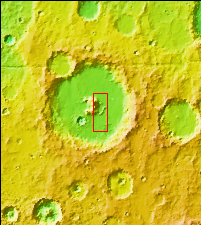
|
Burton Crater
- Click the image above for a larger view
- Full-Res JPEG (1345 x 2653) (274.0 kB)
- Full-Res TIFF (1345 x 2653) (2.4 MB)
Caption:

Context image
Today's VIS image covers part of the central peak and floor of Burton Crater. The central peak slopes are covered with numerous dark streaks. There are several suggested mechanisms to form these features. Two of the mechanisms are that the dusty surface has been altered to reveal darker rock beneath from motion of downward moving dust, or the surface is darkening by fluid or other surface staining.
Orbit Number: 81727 Latitude: -14.0279 Longitude: 203.923 Instrument: VIS Captured: 2020-05-17 17:09
Background Info:
Please see the THEMIS Data Citation Note for details on crediting THEMIS images.
NASA's Jet Propulsion Laboratory manages the 2001 Mars Odyssey mission for NASA's Science Mission Directorate, Washington, D.C. The Thermal Emission Imaging System (THEMIS) was developed by Arizona State University, Tempe, in collaboration with Raytheon Santa Barbara Remote Sensing. The THEMIS investigation is led by Dr. Philip Christensen at Arizona State University. Lockheed Martin Astronautics, Denver, is the prime contractor for the Odyssey project, and developed and built the orbiter. Mission operations are conducted jointly from Lockheed Martin and from JPL, a division of the California Institute of Technology in Pasadena.
Cataloging Keywords:
| Name | Value | Additional Values |
|---|---|---|
| Target | Mars | |
| System | ||
| Target Type | Planet | |
| Mission | 2001 Mars Odyssey | |
| Instrument Host | Mars Odyssey | |
| Host Type | Orbiter | |
| Instrument | Thermal Emission Imaging System (THEMIS) | |
| Detector | ||
| Extra Keywords | Crater, Dust, Grayscale, Thermal | |
| Acquisition Date | ||
| Release Date | 2020-07-17 | |
| Date in Caption | 2020-05-17 | |
| Image Credit | NASA/JPL-Caltech/ASU | |
| Source | photojournal.jpl.nasa.gov/catalog/PIA24005 | |
| Identifier | PIA24005 | |
